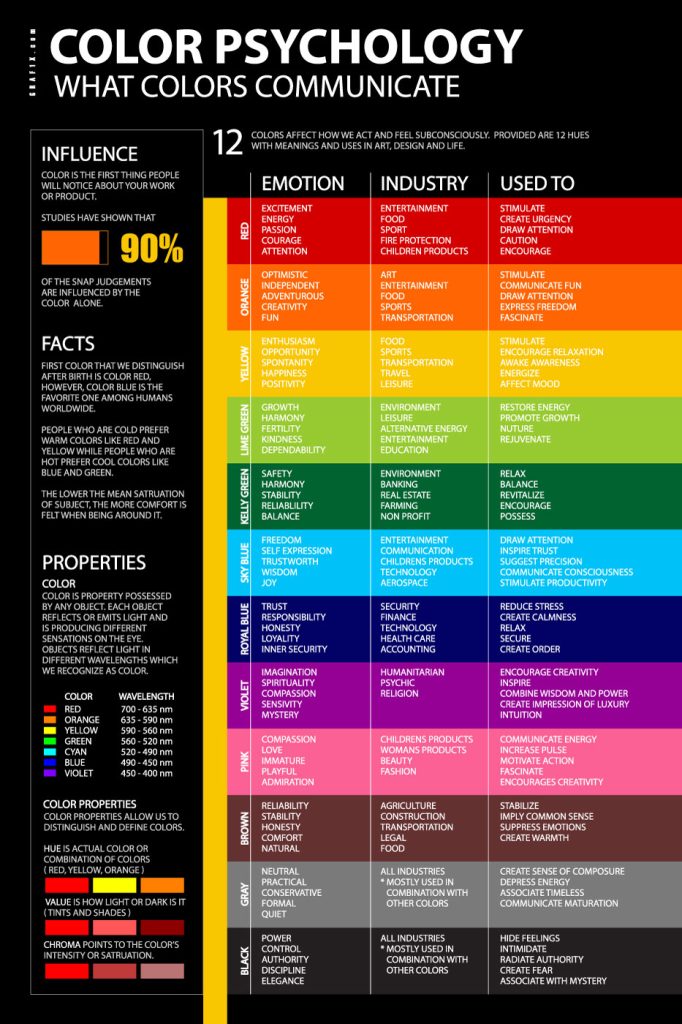Color is far more than just a visual element; it’s a powerful, often subconscious, force that shapes our emotions, influences our behaviors, and even alters our perceptions. We react to color on a primal level, and understanding the principles of color psychology can unlock a deeper appreciation for how these hues impact our experiences, from the products we buy to the spaces we inhabit. Let’s dive into the fascinating world of color psychology and explore how these vibrant (or muted) shades shape our world.
First Impressions: The Decisive Role of Color
Color is often the first thing people notice. It’s an immediate, visceral experience that precedes conscious thought. In fact, studies suggest that a staggering 90% of our snap judgments are based on color alone. This underscores the crucial role color plays in attracting attention, conveying meaning, and creating a lasting impression, whether it’s in branding, design, or even personal style.
The Emotional Spectrum: How Colors Make Us Feel
Colors are intrinsically linked to our emotions. They can energize us, soothe us, excite us, or make us feel uneasy. Understanding these associations is key to harnessing the power of color.
- Red: A dynamic and powerful color, red evokes excitement, energy, passion, and courage. It can also signify urgency, danger, and aggression. Think of the red of a sports car or a stop sign.
- Orange: A vibrant and warm color, orange communicates enthusiasm, optimism, and independence. It’s often used to draw attention and express creativity and freedom.
- Yellow: The color of sunshine, yellow stimulates creativity, fun, and spontaneity. It’s associated with happiness, opportunity, and optimism, but can also sometimes be perceived as caution.
- Green: A refreshing and calming color, green represents growth, harmony, and fertility. It’s strongly associated with nature, peace, and relaxation.
- Blue: A tranquil and trustworthy color, blue evokes feelings of stability, calmness, and security. It’s often used to convey reliability and professionalism.
- Purple: A regal and mysterious color, purple suggests wisdom, spirituality, and royalty. It’s associated with luxury, imagination, and creativity.
- Pink: A gentle and nurturing color, pink communicates compassion, sensitivity, and playfulness. It’s often associated with femininity, love, and admiration.
- Brown: An earthy and grounding color, brown represents reliability, stability, and honesty. It’s associated with nature, comfort, and warmth.
- Gray: A neutral and balanced color, gray conveys practicality, formality, and composure. It’s often used to create a sense of sophistication and calm.
- Black: A powerful and sophisticated color, black represents power, control, and authority. It’s associated with mystery, elegance, and sophistication.
Color in Action: Industry Applications
Different industries strategically leverage color psychology to influence consumer behavior and create specific brand associations.
- Food: Red and orange are often used in food marketing to stimulate appetite, while green and blue are associated with freshness and health.
- Entertainment: Bright, energetic colors like red, yellow, and orange are common in the entertainment industry to create excitement and draw attention.
- Sports: Red and orange are often used to evoke passion and aggression in sports, while blue and green can represent calmness and focus.
- Retail: Retailers use color strategically to influence purchasing decisions. Red and yellow can attract attention, while blue and green create a calming and trustworthy atmosphere.
- Healthcare: Blue and green are prevalent in healthcare settings to promote a sense of calm, healing, and well-being.
- Finance: Blue and green are often used in the financial industry to convey trust, stability, and reliability.
Understanding Color Properties
To truly master color, it’s important to understand its key properties:
- Hue: This refers to the pure color itself, such as red, blue, or green. It’s the name of the color.
- Value: This refers to the lightness or darkness of a color. Adding white to a hue creates a tint, while adding black creates a shade.
- Chroma: This refers to the intensity or saturation of a color. A highly saturated color is vibrant and pure, while a less saturated color appears more muted.
The Language of Color Combinations
Just as individual colors evoke specific emotions, so do color combinations. The interplay of hues can create a wide range of psychological effects. For example, combining red and yellow creates a sense of energy and excitement, while blue and green create a calming and tranquil atmosphere. Understanding these relationships is crucial for effective color usage.
Conclusion: Painting a World of Meaning
Color psychology is a complex and fascinating field that offers valuable insights into the profound impact of color on our lives. By understanding how different colors affect us, we can strategically use them to create desired moods, influence decisions, and communicate more effectively. Whether you’re a designer, marketer, or simply someone interested in the world around you, a deeper understanding of color psychology can enrich your perspective and empower you to create more meaningful and impactful experiences.



